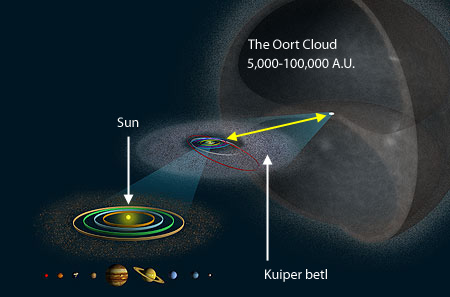Introduction
The Voyager spacecraft, which was launched by NASA in 1977, has been on a mission to explore the far reaches of our solar system that has never been attempted before. Voyager 1 and Voyager 2 have surpassed everyone’s expectations by continuing their journey into interstellar space. The spacecraft’s primary objective was to investigate Jupiter and Saturn when they were launched. As these intrepid explorers travel further away from Earth, one subject that has captivated the imagination of scientists and space enthusiasts alike is whether or not they have arrived at the enigmatic Oort Cloud. The Oort Cloud is a large region that is considered to be the home of comets. In this essay, we look into the most recent discoveries and insights surrounding the possibility that Voyager will come into contact with the Oort Cloud.
What exactly constitutes the Oort Cloud?
At a distance of around 2,000 to 100,000 astronomical units (AU) from the Sun, a hypothetical sphere of frozen objects known as the Oort Cloud is thought to encircle our sun and other planets in our solar system. Jan Oort, a Dutch astronomer, was the one who first suggested the possibility of its existence in the year 1950. It is believed that comets coming from the Oort Cloud are relics from the early formation of the solar system, and as such, they provide important insights into the development of the solar system.
Voyager’s Interstellar Journey
The Voyager’s Interstellar Journey In August of 2012, Voyager 1 made news all around the world when it became the first human-made object to pass the heliopause and reach interstellar space. The heliopause is the boundary that marks the end of the Sun’s effect on the surrounding universe. In November of 2018, its identical twin, Voyager 2, followed suit. These astonishing accomplishments opened a new chapter in the history of human space travel, leading scientists to worry whether or not these pioneering spacecraft might run into the Oort Cloud on their continued excursions across space.
Keeping Tabs on the Voyagers
In order to ascertain whether or not the Voyagers have arrived at the Oort Cloud, scientists rely on a wide variety of data and observations. The observation of charged particles, sometimes known as cosmic rays, by the instruments aboard the Voyager spacecraft is one piece of knowledge that is absolutely essential. The number of cosmic rays coming from the Sun will decrease as the spacecraft travels further away from it, but the number of cosmic rays coming from interstellar space will rise. These variations are being studied by scientists so that they can get insight about the location of the Voyagers in relation to the Oort Cloud.
Obstacles to Overcome and Restrictions
Unprecedented difficulties arise while attempting to ascertain whether or not the Voyagers have arrived at the Oort Cloud. To begin, the Oort Cloud is so far away from Earth that there haven’t been any direct observations made of it, therefore our knowledge of its precise borders and properties is limited at best. There are also restrictions placed on the precision and frequency of data collection as a result of the aged instruments aboard the Voyagers and the restricted power supply. In spite of this, scientists make the most of every opportunity that presents itself in order to amass information and push the bounds of our current knowledge.
Latest Insights:
Scientists have been able to make educated calculations regarding the placement of the Voyagers in relation to the Oort Cloud based on the data acquired from those spacecraft. Recent research suggests that Voyager 1 is still on its approach to reaching the Oort Cloud, while Voyager 2, which has a different trajectory, is expected to join the region in the next years. Both of these spacecraft will arrive there at different times. However, due to the unpredictability of the Oort Cloud and the complexity of interstellar space, these projections are subject to continual modification as new data becomes available. This is the case because the Oort Cloud is made up of dust and gas.
The Legacy of Voyager
In spite of the fact that it is unknown whether or not the Voyagers have arrived to the Oort Cloud, the enduring legacy that they have left behind is incontestable. Even after more than four decades, these spacecraft continue to relay crucial data and have given humans vistas into the furthest limits of our solar system that have never been seen before. Their durability and tenacity are a monument to the inventiveness of humans and the unquenchable curiosity that compels us to learn more about the world around us.
Even while it is not yet known for certain whether or not Voyager has arrived at the Oort Cloud, the historic trip taken by the Voyager spacecraft continues to serve as motivation for present and future efforts to explore space. These stalwart representatives of humanity have pushed the limits of our comprehension and unquestionably will leave an unforgettable mark.
![]()
